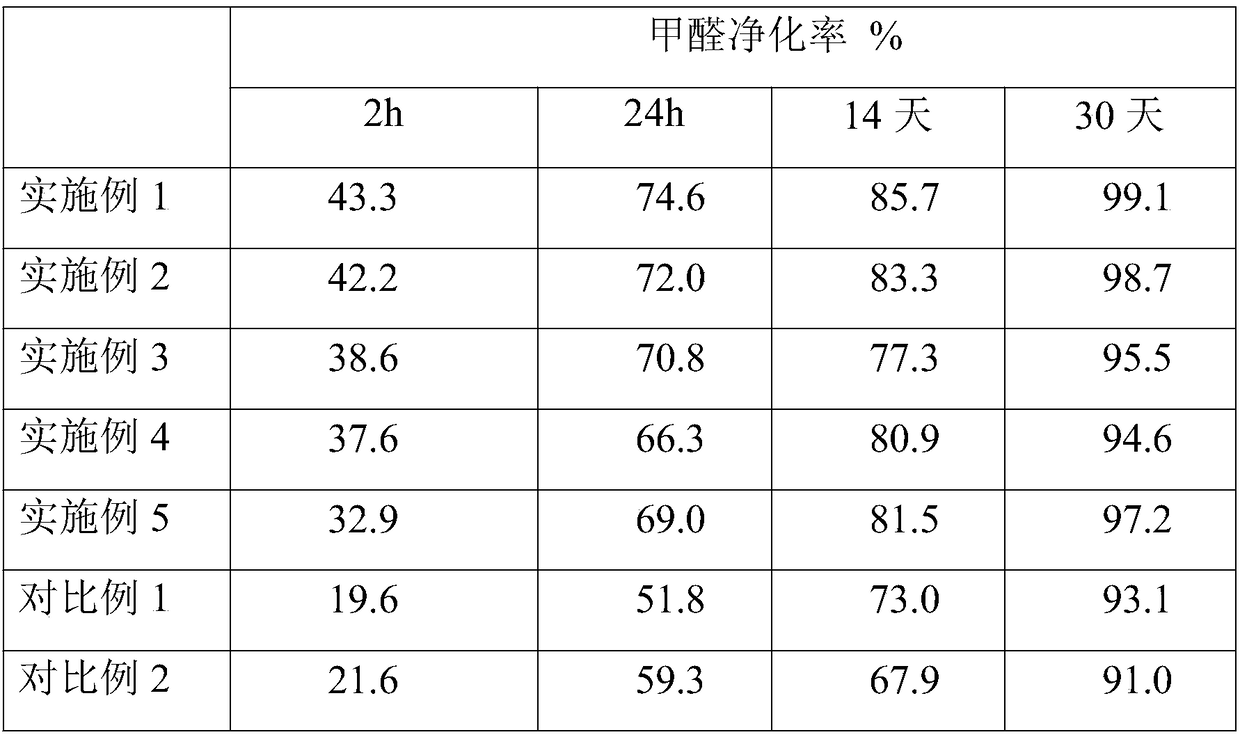Preparation method for adsorptive catalyst for in situ degradation of formaldehyde
A catalyst and formaldehyde technology, applied in chemical instruments and methods, physical/chemical process catalysts, separation methods, etc., can solve the problems of low conversion rate of formaldehyde, easy deactivation of catalysts, and low conversion efficiency of formaldehyde
- Summary
- Abstract
- Description
- Claims
- Application Information
AI Technical Summary
Problems solved by technology
Method used
Image
Examples
preparation example Construction
[0013] The present invention also provides a preparation method of the adsorption catalyst for in-situ degradation of formaldehyde, comprising the following steps:
[0014] (1) Add a foaming agent to the nylon 66 emulsion and mix evenly, then electrospin to obtain nylon 66 fibers, and calcinate the nylon 66 fibers at 300-450°C for 2-4 hours to obtain porous carbon fibers;
[0015] (2) After mixing porous carbon fiber, attapulgite, silane coupling agent and organic titanate in a solvent, ultrasonication for 15-30 minutes, and then sealing reaction at 80-120°C for 3-6 hours, to obtain modified porous carbon fiber ;
[0016] (3) Ultrasonic disperse the modified porous carbon fiber in a solvent for 15-30 minutes, then add polydiallyldimethylammonium chloride, continue ultrasonication for 30-45 minutes, then add graphene oxide, and stir for 30-45 minutes to obtain Adsorption catalysts for in situ degradation of formaldehyde.
[0017] In the present invention, a foaming agent is f...
Embodiment 1
[0026] An adsorption catalyst for in-situ degradation of formaldehyde, made of the following materials in parts by weight: 10 parts by weight of attapulgite, 8 parts by weight of tetraethyl titanate, 3.5 parts by weight of silane coupling agent KH580, and 6 parts by weight of graphene oxide parts, 5 parts by weight of polydiallyldimethylammonium chloride, 3 parts by weight of sodium carbonate, 100 parts by weight of nylon 66 emulsion, and 50 parts by weight of water.
[0027] The preparation method of the adsorption catalyst of described in-situ degradation formaldehyde, comprises the following steps:
[0028] (1) Add sodium carbonate to nylon 66 emulsion and mix evenly, then obtain nylon 66 fiber by electrospinning. The pitch of the needles of the silk unit is 35cm, and the number of needles of the spinning unit is 90;
[0029] Calcining nylon 66 fibers at 350°C for 3 hours to obtain porous carbon fibers;
[0030] (2) After the attapulgite is ground evenly, pass through a 2...
Embodiment 2
[0034] An adsorption catalyst for in-situ degradation of formaldehyde, made of the following parts by weight: 12 parts by weight of attapulgite, 10 parts by weight of tetramethyl titanate, 3.2 parts by weight of silane coupling agent KH590, and 6 parts by weight of graphene oxide 6 parts by weight of polydiallyldimethylammonium chloride, 3 parts by weight of N,N'-dinitrosopentamethylenetetramine, 120 parts by weight of nylon 66 emulsion, and 50 parts by weight of ethanol.
[0035] (1) Add N,N'-dinitrosopentamethylenetetramine to nylon 66 emulsion and mix evenly, then electrospin to obtain nylon 66 fiber. The electrospinning process is: power supply voltage 50kV, spinning The temperature is 35°C, the relative humidity is 75%; the needle spacing of the multi-needle spinneret unit is 35cm, and the number of needleheads of the spinneret unit is 90;
[0036] Calcining nylon 66 fibers at 400°C for 2.5 hours to obtain porous carbon fibers;
[0037] (2) After the attapulgite is ground ...
PUM
 Login to View More
Login to View More Abstract
Description
Claims
Application Information
 Login to View More
Login to View More - R&D
- Intellectual Property
- Life Sciences
- Materials
- Tech Scout
- Unparalleled Data Quality
- Higher Quality Content
- 60% Fewer Hallucinations
Browse by: Latest US Patents, China's latest patents, Technical Efficacy Thesaurus, Application Domain, Technology Topic, Popular Technical Reports.
© 2025 PatSnap. All rights reserved.Legal|Privacy policy|Modern Slavery Act Transparency Statement|Sitemap|About US| Contact US: help@patsnap.com

